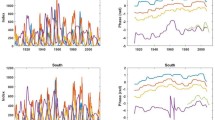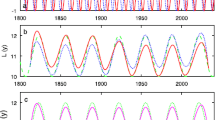Abstract
This paper applies a Kuramoto model of coupled oscillators to investigate the north–south (N–S) solar asymmetry and properties of meridional circulation. We focus our study on the asymmetry of the 11-year phase, which is slight but persistent: only two changes of sign (around 1928 and 1968) are observed in the past century. We present a model of two non-linear coupled oscillators that links the hemispheric phase asymmetry of sunspots with the asymmetry of the meridional flow. We use a Kuramoto model with evolving frequencies and constant symmetric coupling to show how asymmetry in meridional circulation could produce a persistent phase lead of one solar hemisphere over the other. We associate the natural frequencies of the two oscillators with the velocities of the meridional flow cells in the northern and southern hemispheres. We assume the respective circulations to be independent and estimate the value of the relevant cross-equatorial coupling by the coupling coefficient in the Kuramoto model. We find that a persistent N–S asymmetry of sunspots and the change of the leading hemisphere could indeed both be the result of the evolving frequencies of meridional circulation; the necessary asymmetry of the meridional flow may be small; and the cross-equatorial coupling has an intermediate range value. Possible applications of these results in solar dynamo models are discussed.








Similar content being viewed by others
References
Badalyan, O.G.: 2011, Astron. Rep. 55, 928. DOI .
Badalyan, O.G., Obridko, V.N.: 2011, New Astron. 16, 357. DOI .
Badalyan, O.G., Obridko, V.N., Sykora, J.: 2008, Solar Phys. 247, 379. DOI .
Ballester, J.L., Oliver, R., Carbonell, M.: 2005, Astron. Astrophys. 431, L5. DOI .
Belucz, B., Dikpati, M.: 2013, Astrophys. J. 779, 4. DOI .
Blanter, E., Le Mouël, J.-L., Shnirman, M., Courtillot, C.: 2014, Solar Phys. 289, 4309. DOI .
Blanter, E., Le Mouël, J.-L., Shnirman, M., Courtillot, C.: 2016, Solar Phys. 291, 1003. DOI .
Brun, A.S., Browning, M.K., Dikpati, M., Hotta, H., Strugarek, A.: 2015, Space Sci. Rev. 196, 101. DOI .
Carbonell, M., Oliver, R., Ballester, J.L.: 1993, Astron. Astrophys. 274, 497.
Carbonell, M., Terradas, J., Oliver, R., Ballester, J.L.: 2007, Astron. Astrophys. 476, 951. DOI .
Charbonneau, P.: 2010, Living Rev. Solar Phys. 7, 3. DOI .
Charbonneau, P.: 2014, Annu. Rev. Astron. Astrophys. 52, 251. DOI .
Chowdhury, P., Choudhary, D.P., Gosain, S.: 2013, Astrophys. J. 768, 188. DOI .
Deng, L.-H., Qu, Z.-Q., Liu, T., Huang, W.-J.: 2011, J. Korean Astron. Soc. 44, 209. DOI .
Deng, L.-H., Qu, Z.-Q., Yan, X.-L., Wang, K.-R.: 2013, Res. Astron. Astrophys. 13, 104. DOI .
Donner, R., Thiel, M.: 2007, Astron. Astrophys. 475, L33. DOI .
Hathaway, D.H.: 2015, Living Rev. Solar Phys. 12, 4. DOI .
Hathaway, D.H., Rightmire, L.: 2010, Science 327, 1350. DOI .
Hathaway, D.H., Upton, L.: 2014, J. Geophys. Res. 119, 3316. DOI .
Hathaway, D.H., Wilson, R.M.: 2004, Solar Phys. 224, 5. DOI .
Hazra, G., Karak, B.B., Choudhuri, A.R.: 2014, Astrophys. J. 782, 9. DOI .
Hong, H., Strogatz, S.H.: 2011, Phys. Rev. Lett. 106, 054102. DOI .
Jiang, J., Hathaway, D.H., Cameron, R.H., Solanki, S.K., Gizon, L., Upton, L.: 2014, Space Sci. Rev. 186, 491. DOI .
Karak, B.B.: 2010, Astrophys. J. 724, 1021. DOI .
Karak, B.B., Choudhuri, A.R.: 2011, Mon. Not. Roy. Astron. Soc. 410, 1503. DOI .
Knaack, R., Stenflo, J.O., Berdyugina, S.V.: 2004, Astron. Astrophys. 418, L17. DOI .
Kuznetsov, A.P., Sedova, Y.V.: 2014, Int. J. Bifurc. Chaos Appl. Sci. Eng. 24, 1430022. DOI .
Leander, R., Lenhart, S., Protopopescu, V.: 2015, Physica D 301, 36. DOI .
Li, K.J., Gao, P.X., Zhan, L.S.: 2009, Solar Phys. 254, 145. DOI .
Lopes, I., Passos, D.: 2009, Solar Phys. 257, 1. DOI .
Lopes, I., Silva, H.G.: 2015, Astrophys. J. 804, 120. DOI .
Lopes, I., Passos, D., Nagy, M., Petrovay, K.: 2014, Space Sci. Rev. 186, 535. DOI .
Maistrenko, V., Vasylenko, A., Maistrenko, Yu., Mosekilde, E.: 2010, Int. J. Bifurc. Chaos Appl. Sci. Eng. 20, 1811. DOI .
McIntosh, S.W., Leamon, R.J., Gurman, J.B., Olive, J.-P., Cirtain, J.W., Hathaway, D.H., et al.: 2013, Astrophys. J. 765, 146. DOI .
Mininni, P.D., Gomez, D.O., Mindlin, G.B.: 2000, Phys. Rev. Lett. 85, 5476. DOI .
Mininni, P.D., Gomez, D.O., Mindlin, G.B.: 2001, Solar Phys. 201, 203. DOI .
Muraközy, J., Ludmány, A.: 2012, Mon. Not. Roy. Astron. Soc. 419, 3624. DOI .
Nagovitsyn, Y.A., Kuleshova, A.I.: 2015, Geomagn. Aeron. 55, 887. DOI .
Nagy, M., Petrovay, K.: 2013, Astron. Nachr. 334, 964. DOI .
Nandy, D., Muñoz-Jaramillo, A., Martens, P.C.H.: 2011, Nature 471, 80. DOI .
Newton, H.W., Milsom, A.S.: 1955, Mon. Not. Roy. Astron. Soc. 115, 398.
Norton, A.A., Charbonneau, P., Passos, D.: 2014, Space Sci. Rev. 186, 251. DOI .
Norton, A.A., Gallagher, J.C.: 2010, Solar Phys. 261, 193. DOI .
Passos, D., Charbonneau, P., Miesch, M.: 2015, Astrophys. J. Lett. 800, L18. DOI .
Passos, D., Lopes, I.: 2008, Solar Phys. 250, 403. DOI .
Passos, D., Lopes, I.P.: 2011, J. Atmos. Solar-Terr. Phys. 73, 191. DOI .
Rightmire-Upton, L., Hathaway, D.H., Kosak, K.: 2012, Astrophys. J. 761, 14. DOI .
Schad, A., Timmer, J., Roth, M.: 2012, Astron. Nachr. 333, 991. DOI .
Schad, A., Jouve, L., Duvall, T.L., Roth, M., Vorontsov, S.: 2015, Space Sci. Rev. 196, 221. DOI .
Shetye, J., Tripathi, D., Dikpati, M.: 2015, Astrophys. J. 799, 220. DOI .
Strogatz, S.H.: 2000, Physica D 143, 1. DOI .
Svalgaard, L., Kamide, Y.: 2013, Astrophys. J. 763, 23. DOI .
Sýkora, J., Rybák, J.: 2010, Solar Phys. 261, 321. DOI .
Temmer, M., Rybák, J., Bendík, P., Veronig, A., Vogler, F., Otruba, W., Pötzi, W., Hanslmeier, A.: 2006, Astron. Astrophys. 447, 735. DOI .
Turck-Chièze, S., Couvidat, S.: 2011, Rep. Prog. Phys. 74, 6901. DOI .
Virtanen, I.I., Mursula, K.: 2014, Astrophys. J. 781, 99. DOI .
Vizoso, G., Ballester, J.L.: 1990, Astron. Astrophys. 229, 540.
Zhao, J., Bogart, R.S., Kosovichev, A.G., Duvall, T.L. Jr., Hartlep, T.: 2013, Astrophys. J. Lett. 774, L29. DOI .
Zolotova, N.V., Ponyavin, D.I.: 2006, Astron. Astrophys. 449, L1. DOI .
Zolotova, N.V., Ponyavin, D.I.: 2007, Solar Phys. 243, 193. DOI .
Zolotova, N.V., Ponyavin, D.I., Marwan, N., Kurths, J.: 2009, Astron. Astrophys. 503, 197. DOI .
Zolotova, N.V., Ponyavin, D.I., Arlt, R., Tuominen, I.: 2010, Astron. Nachr. 331, 765. DOI .
Zou, Y., Donner, R.V., Marwan, N., Small, M., Kurth, J.: 2014, Nonlinear Process. Geophys. 21, 1113. DOI .
Acknowledgements
We thank the anonymous referee for constructive comments and interesting suggestions. This is IPGP contribution No. 3828. We are grateful to Dr. David H. Hathaway for the Greenwich–USAF/NOAA Sunspot Data.
Author information
Authors and Affiliations
Corresponding author
Ethics declarations
Disclosure of Potential Conflict of Interest
Authors declare that they have no conflict of interest.
Appendix
Appendix
It is well known that the solar activity spectrum contains frequencies outside the 11 yr band of periods. These frequencies may contaminate the 11 yr phase. In the main text we apply a Kuramoto model to 1 yr preliminary averaged data. This averaging reduces oscillations with periods below 1 year. However, so-called quasi-biennial oscillations with periods from 2 to 4 years may still affect the 11 yr phase evolution. We perform our analysis on 2 yr and 4 yr preliminary averaged data. Figure 9 (top) shows the cumulative energy of periods between 2 and 4 years in the 11 yr sliding window normalized to the energy of the 11 yr component. The relative energy reaches 0.15 after 1 yr preliminary averaging of data, but after 4 yr averaging, its maximum is equal to 0.06. The evolution of the phase difference \(\Delta\Phi\) between the northern and southern hemispheres is presented in the bottom panel of Figure 9, and we see the same profile independent of the preliminary averaging. We can see the contamination of the 11 yr phase by high-frequency oscillations of the solar activity as high-frequency variations of the natural frequencies (Figure 10). These oscillations are smoothed by 4 yr preliminary averaging, and the long-term evolution of natural frequencies remains the same. The estimate of the optimum coupling relevant to the 4 yr preliminary averaging is slightly higher: \(\kappa_{0} = 0.59\) instead of 0.55 relevant to the 1 yr preliminary averaging used in the main text (Figure 11).
Influence of preliminary averaging on the 11 yr phase evolution. Top: Relative energy of periods between 2 and 4 years; bottom: evolution of 11 yr phase difference between the north and south hemispheres estimated in the 11 yr sliding window. The sliding window of preliminary averaging is 1 yr (blue), 2 yr (red), and 4 yr (yellow).
Rights and permissions
About this article
Cite this article
Blanter, E., Le Mouël, JL., Shnirman, M. et al. Reconstruction of the North–South Solar Asymmetry with a Kuramoto Model. Sol Phys 292, 54 (2017). https://doi.org/10.1007/s11207-017-1078-3
Received:
Accepted:
Published:
DOI: https://doi.org/10.1007/s11207-017-1078-3







